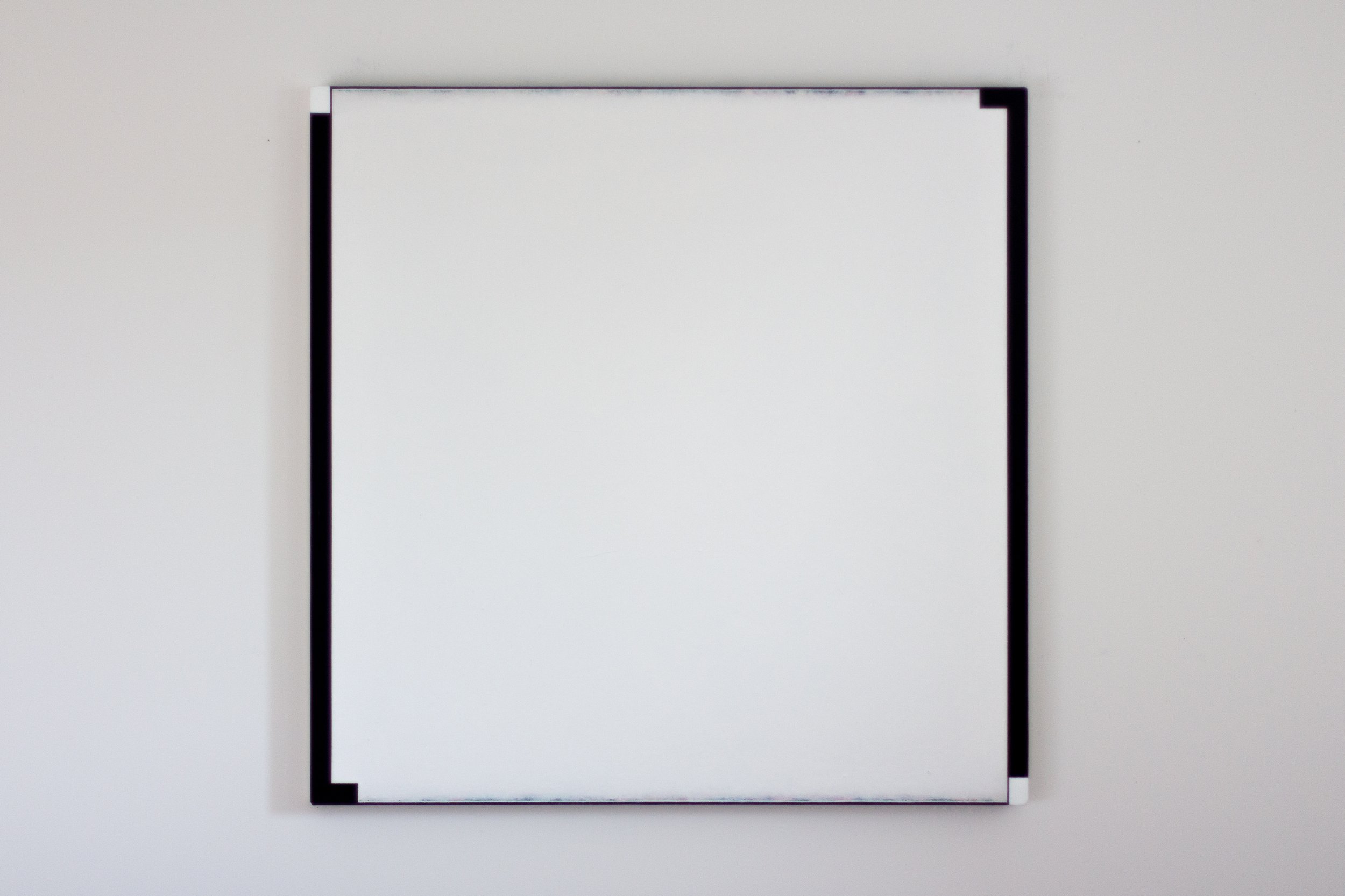Peter Adsett, Tri-Nations
Peter Adsett, Tri Nations 1st, 2nd & 3rd Test (2021), Acrylic on linen, 106cm sq. exclusive to PAULNACHE, Tūranganui-a-Kiwa Gisborne
‘Tri-Nations’ installation at PAULNACHE opened Waitangi Day 2022. Photograph by Tom Teutenberg
After decades studying Māori art, and that of central desert aboriginal artists, Peter Adsett brings new dimensions to his medium of abstract painting. He shares with the latter a technique of horizontality, working flat on the ground, since by this means he avoids looking at the world across distance, with a measuring eye, and thus achieving “good form” (gestalt), which he understands as a kind of picturing. Picturing, in turn, is the imitation of a model, an original, that remains outside painting, at a remove from the material object, the canvas.
Adsett’s tertiary education at Palmerston North Teacher’s College under Cliff Whiting, Frank Davis and others, also shaped this approach to his medium, as did his childhood apprenticeship in his father’s cabinetmaking workshop in Gisborne. Furthermore, growing up in the vicinity of Matawhero fostered an early sense of historic injustices. In recent decades Adsett has dealt with the related massacres at Matawhero, and Ngatapa Pa (Matawhero, Bullet Holes and Bandages, 2009; Betrayal 2012), both exhibitions having been endorsed by Ngāi Tāmanuhiri elder, Olivia Horowia Bradbrook, before travelling to different sites in the North Island.
In late 2019 Adsett was in Gisborne to mount a two-part exhibition at PAULNACHE Gallery entitled October, and Navigation. The show marked the 250th anniversary of Cook’s landing in Poverty Bay, an event that was highly sensitive for the local population. The paintings were devoid of any imaginable expressiveness, being constructed from pale, cream-coloured raw linen. All the markings – vertical lines of black, cream and grey acrylic – were banished to the far extremes and side edges of the stretcher. On the reverse side of each painting is the date of a particular conflict from colonial times. The series signalled history’s general silence on such matters. On a neighbouring wall, the theme continued with a vast wall on which the painter combined black geometry with erased drawings, leaving ghostly imprints, nails and holes, and naming the whole, with unmissable irony, Navigation.
Adsett’s most recent work, made during the long Covid-19 lockdown in Victoria, has turned to black and white relations in a trio of paintings titled Tri-Nations. Begun at the time of the ‘All Blacks’ rugby success in Australia in 2020, and coinciding with the ‘Black Lives Matter’ protests in the USA, with its echoes in Melbourne and Sydney, the work develops a significant aspect of the October series. With his habitual ironic humour, Adsett focusses the spectator’s gaze on the off-sides, the edges of the (‘playing’) field. The surprise produced by this wit is more than a match for the deft, balletic play of the kiwi team.
Travelling back and forth between New Zealand and Australia, for the purposes of teaching and exhibiting, and maintaining close, familial links in both countries, the painter has created his own one-man cross-Tasman ‘bubble!’
– Mary Alice-Lee
Trans Tasman Exhibitions
Tri-Nations runs in conjunction with Adsett’s solo exhibition ‘Foul Play’ at Araluen Art Centre, Alice Springs, Northern Territories in Australia which has been curated by Stephen Williamson to coincide & conclude on the 20th of March 2022.
Paintings
Exhibition Information
Series title: Tri-Nations 1st, 2nd & 3rd Test
Year created: 2021
Medium: horizontality
Materials: Acrylic on linen
Dimensions: 106cm sq. x 6cm (D)
Provenance: painted at Humbug, the artist home and studio, Melbourne
Signed: and numbered verso
Biography
Born in Gisborne, New Zealand, in 1959, Peter Adsett has lived and worked in Australia since 1981, developing his painting practice. He exhibits regularly in both countries, and has had shows overseas in New York and Boston.
His academic credentials include an MFA from the Northern Territory University, and a PhD from Australian National University. In 2001 he was awarded a grant from the Pollock-Krasner Foundation and enjoyed residencies in the International Studio and Curatorial Program in New York, and the McDowell Colony in New Hampshire. Adsett’s work is held in institutions and museums in Australia, New Zealand and Japan.
Adsett has devoted twenty years now to an investigation of abstraction, and like such iconic figures as Richard Serra and Robert Ryman, he proves the enterprise to be one of great, untapped potential. One could even view Adsett’s art as a critique of abstract painting from the early 20th century to today, a task that became further complicated when he confronted the art of Indigenous Australians - what many believe is the most powerful painting produced today.
In 2000 he completed a series of large-scale acrylic paintings in collaboration with the Gija artist, Rusty Peters. The resulting exhibition of fourteen works (seven each), titled Two Laws, One Big Spirit travelled around Australia and New Zealand.
In 2009, Adsett built a house/studio in southern Victoria that was the fruit of another collaboration, this time with a New Zealand architect, Sam Kebbell. The innovative and much admired building (now housing Adsett and his family) is regarded as a “dialogue between painting and architecture.”
Credits
Text written by art historian Mary Alice-Lee
Photography by Felix Adsett, © the artist, courtesy of PAULNACHE









